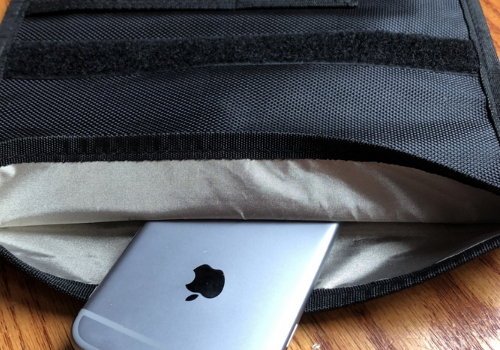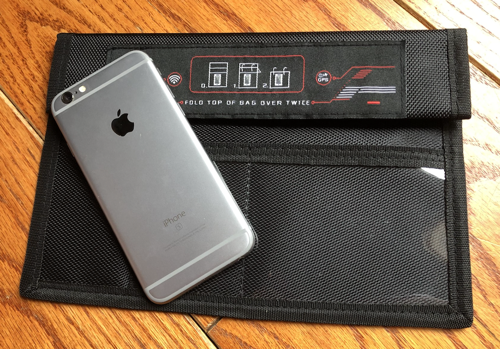Have you ever worried about your personal or financial information being stolen? Identity theft and fraud are all too common now.
According to Security Magazine, over 2,200 cyberattacks occur every day. That’s 1 every 39 seconds. Big companies, small businesses, and individuals are all at risk.
Instead of the nightmare that comes with having your banking, credit cards or personal information stolen, take extra steps to prevent this. An easy way to not become a victim is to protect your data by using a Faraday bag.

I first discovered Faraday bags a few years ago and immediately loved the concept of them and the protection and privacy they provide.
Now I own several shielding bags, a faraday backpack, and pouches. Here is post narrowing down the best Faraday bags on the market in 2025.
So What is a Faraday Bag?
It’s a simple invention really. A shielded silver-lined or other blocking fabric pouch that prevents tech spies and hackers from being able to steal your information from your cell phone, laptop, tablet, key fob, and any cards you have with RFID chips.
The signal basically bounces around the fabric. It doesn’t reach your electronics inside the bag. So Wifi, cellular, Bluetooth, RFID, and GPS signals cannot ping to your device.
They come in small pouches for small devices and keyfobs, backpacks, duffel bags, purses, laptop bags, storage boxes, and even gigantic bags that can hold generators and solar panels.

When Should I Use a Shielding Bag?
I think it’s useful all the time. You never know when a hacker may target your device so having your mobile phone in one all the time, keeps your device safer. Plus it blocks EMFs, added safety for you.
If you’re concerned about people or the higher powers tracking your location then this will block your signal and mean you cannot be tracked.
But it’s most important to use in busy public places – like the airport, train, subway stations. This is where you’re more likely to be hacked. And especially in high tourist locations. The last thing you want is to be on vacation in another country with maxed out credit cards from some thief. Or find out your identity has been stolen and have to deal with clearing up that mess.
I do not travel without my Faraday backpack to protect my laptop, tablet and iPhone and a Faraday pouch to keep my passport, keyfob, credit cards and debit cards with RFID chips. Better safe than sorry.
How Do They Protect Against Hackers?
Hackers today don’t have to touch your phone or other devices. They can access your devices remotely.

Spyware can be installed onto your phone through cloud servers and remote devices, intersected signals, and RFID readers.
Sadly, it’s not that complex anymore and these kinds of devices can be easily purchased online so all kinds of criminals can easily become hackers.
Faraday pouches, sleeves, and bags are an extra layer of protection for when you are out in busy places, where hackers are just waiting to attack unsuspecting victims with these devices. You can read my post 7 reasons to buy a Faraday Bag here to learn more.
How Can My Wireless Electronics Be Hacked?
Here are just some of the more common types of digital hacking currently being used by criminals. I’m sure as I’m writing this, newer strategies are being developed in this constant cybersecurity battle.
There’s a reason worldwide spending on cybersecurity is estimated to be about $182.86 billion in 2023.
1. Wifi Jacking
Hackers set up near a public Wifi location and use a powerful device to point at your smartphone, laptop, or tablet and force it onto their network. Here they can steal your passwords, emails, credit card and banking info, and take over your phone.
2. Bluesnarfing
This is a way hackers get into your wireless device through your Bluetooth connection and can then access all information stored on the device.

They occur when your Bluetooth is on and set to discoverable to others.
There are other ways to attack through Bluetooth, like Blue bugging and Blue jacking.
3. RFID Skimming
This is basically digital pick pocketing. A thief uses a device to read your credit card or debit card. They can then duplicate your card and use it. For passports with RFID chips, your data can be stolen to make fake passports.
I have an entire blog post about RFID skimming here if you want to learn more about it.
4. RFID Relay Attack
Criminals use long-range readers to trick your car into unlocking and starting. Making it easy for them to steal your vehicle from your home or office. These readers act like an extension cord between your key fob and your vehicle.
WiPhishing
5. Rogue Wireless Access Points
These are unauthorized WiFi hotspots (access points) on a network. It allows a hacker to intercept your data flowing through the network. You’re most likely to encounter these in public spaces either as a free wireless hotspot but they can be password protected.
6. Zero-Click Attacks
These attacks don’t require any interaction with your phone. They get into your device through flaws or bugs in your operating system or apps.

They can even get into your device through an app call you don’t answer. You can learn more about them in this study.
7. Eavesdropping/Sniffing
Accesses data in transit between two devices. Hackers can intercept this information, delete, it or change it. Attackers can use devices to pick up sound, images, video meetings, etc. and convert them into a format so they can eavesdrop.
8. RF Jamming
Wireless signals are at risk of electromagnetic and radio-frequency interference. RF jamming disrupts and distorts the transmission through a satellite so your signal (or message or email) doesn’t reach the receiving end. It can block you from communicating with other devices.
9. Spearphishing
This is a popular and dangerous attack, where hackers trick victims into clicking on a malicious link and inputting their personal information. A spear phisher will research a user or their target and send an email or text targeting them to obtain personal information.
10. Replay Attack
A criminal acts as a man in the middle, intercepting a message being sent and resending it as an authentic message to where they want it send. One way this is used is to intercept requests for e-transfers. The sender replies with the e-transfer, not knowing it’s going into a hacker’s account.
11. Cryptojacking
A type of crime where your mobile device or computer’s power is used without your knowledge or permission to mine cryptocurrencies. Cryptojacking software is installed on your device and runs in the background.
Symptoms of this include; overheating of your battery, noticeable slow down in your phone’s speed and productivity, unexpected electricity costs, and your device suddenly shutting down.
Conclusion – Shield up Because Hackers are Everywhere
There are so many ways hackers can get into your cell phone, laptop, or tablet to gain access to your financial and personal information. You’re at risk, as are small businesses and large corporations.
With how easy it is to be attacked, it is important to be cautious and take steps to avoid having your money, identity, personal or work information stolen from you. A Faraday bag will block all signals from reaching your device, meaning no hacker will be able to reach your electronics. You can learn more ways to protect your cell phone from hackers here.
Create a vault around your important digital information with a Faraday bag.
Resources
https://www.theguardian.com/news/2021/jul/18/what-is-pegasus-spyware-and-how-does-it-hack-phones
https://www.getastra.com/blog/security-audit/cyber-security-statistics/
